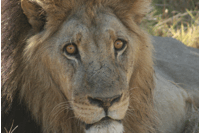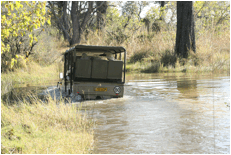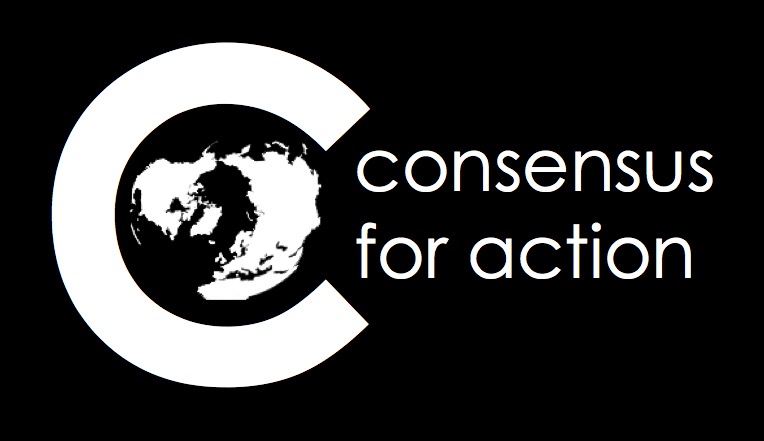By Anthony D. Barnosky, Professor in the Department of Integative Biology, Curator in the Museum of Paleontology, and Research Paleoecologist in the Museum of Vertebrate Zoology at the University of California, Berkeley. His new book Dodging Extinction: Power, Food, Money, and the Future of Life on Earth (University of California Press, Fall 2014) explores in more detail how people can keep wild species and wild places on Earth.
(This is the fifth of six blogs about my reflections on wild places and wild species—what they are and why they are important—written as I traveled through parts of Africa this past summer.)
Feeling Wild
My soul is at peace. That's how I know I'm in the wild.
 Maybe part of it is that it feels like
autumn, always my favorite season. Here
in Botswana's Okavango Delta, though, it's technically winter and what I'd call
an Indian summer day where I come from is occurring in late June, not late
September. Maybe part of my contentment
is because I'm sitting here in the shade, outside the little tent cabin Liz and
I are sharing, looking out on waving marsh grass, heads like feathers, but much
taller than my own six feet of humanity.
Breaks of blue-green water peek out of the grass. We're on a meander that is right on the edge
of the delta.
Maybe part of it is that it feels like
autumn, always my favorite season. Here
in Botswana's Okavango Delta, though, it's technically winter and what I'd call
an Indian summer day where I come from is occurring in late June, not late
September. Maybe part of my contentment
is because I'm sitting here in the shade, outside the little tent cabin Liz and
I are sharing, looking out on waving marsh grass, heads like feathers, but much
taller than my own six feet of humanity.
Breaks of blue-green water peek out of the grass. We're on a meander that is right on the edge
of the delta.
In the middle of the night we heard hippos splash out of the water and spend some time munching the grass right outside the canvas walls. On safari this morning, it was quiet when we killed the engine, only the sound of the breeze, birdsong, the rustling of the grass. Even the elephants were quiet, as we parked there in the midst of a herd that milled around us. I counted at least fifty; it's my guess the real number was close to a hundred.
 Likewise the lions we came across were
serene, resting in the shade, all three of them lazy males. Liz spotted them there in the tall grass, two
of them sprawled out sound asleep, the other one with his paws stretched out in
front, hind quarters cocked to the side, head up, quietly watching us watch
him. Crocodile on the bank, fish eagle
in the tree, pelicans and flamingoes herding fish in a drying out pond. Nobody seemed to have a care in the world.
Though I suspect the fish did.
Likewise the lions we came across were
serene, resting in the shade, all three of them lazy males. Liz spotted them there in the tall grass, two
of them sprawled out sound asleep, the other one with his paws stretched out in
front, hind quarters cocked to the side, head up, quietly watching us watch
him. Crocodile on the bank, fish eagle
in the tree, pelicans and flamingoes herding fish in a drying out pond. Nobody seemed to have a care in the world.
Though I suspect the fish did.
The other thing is the smells. At one point there was sage—sweeter than the sagebrush I'm used to, but familiar enough to make me feel good. Marsh mud, not strong, tempered by the hay-smell of drying grass. And unfamiliar, yet familiar: animals, different kinds, that had recently gone by, and more pungent yet (but in a good way), the earthy smell of elephant droppings.
Getting here is not all that easy, and I'm sure that's one of the things that makes it my kind of wild. We took the quickest route, a thirty-minute flight from Maun in a seven-seat bush plane. From our vantage it was easy to see why driving to the Okavango from our takeoff point would entail six to eight hours in the best of conditions, much of it on a two rut road, and a couple of days if the water is running high, even though it's only an 80 mile drive, give or take.
 We're here when the water is fairly high.
The rainy season in Angola stopped more than a month ago, but it's taken all
this time for the water to finally make its way along the Namibian border and
spread out in a broad fan here, where tectonic warping has dropped the land
surface a little lower than up north.
From our bird’s eye view, the result looks like loosely braided blue-black
ribbons, which are actually of water.
Between each of the watery strands are islands and strips of land, some
big, some small, but all of them with their concentric bands of bright green
next to the water giving way to golden brown a little higher up where the
grasses have already dried, to deeper forest or olive green in the places where
the trees never get drowned. As the
season goes on we're told, the bands of brown get wider, and the bright green
marshy areas and blue water begin to disappear under the relentless African
summer sun.
We're here when the water is fairly high.
The rainy season in Angola stopped more than a month ago, but it's taken all
this time for the water to finally make its way along the Namibian border and
spread out in a broad fan here, where tectonic warping has dropped the land
surface a little lower than up north.
From our bird’s eye view, the result looks like loosely braided blue-black
ribbons, which are actually of water.
Between each of the watery strands are islands and strips of land, some
big, some small, but all of them with their concentric bands of bright green
next to the water giving way to golden brown a little higher up where the
grasses have already dried, to deeper forest or olive green in the places where
the trees never get drowned. As the
season goes on we're told, the bands of brown get wider, and the bright green
marshy areas and blue water begin to disappear under the relentless African
summer sun.
 The fluctuating water levels and deep sand
it leaves behind are why there are few roads into this place, and of those
there are, why parts of them are submerged by water and impassable for much of
the year. Even now, it can be touch and
go. This morning we dipped our land rover nose-deep into a couple of ponds the
road runs through, and I wasn't all that sure we'd make it to other side. We always did, but not so for two other
vehicles in our party, who apparently spent much of their morning stuck in a
thigh-deep water crossing. Where there
wasn't water on the road, the sand can make travel tricky—in
one place this morning, our wheels just spun, land rover stationary, sand
flying, in a maneuver that got us going, but just as easily could have dug us
down to our axle.
The fluctuating water levels and deep sand
it leaves behind are why there are few roads into this place, and of those
there are, why parts of them are submerged by water and impassable for much of
the year. Even now, it can be touch and
go. This morning we dipped our land rover nose-deep into a couple of ponds the
road runs through, and I wasn't all that sure we'd make it to other side. We always did, but not so for two other
vehicles in our party, who apparently spent much of their morning stuck in a
thigh-deep water crossing. Where there
wasn't water on the road, the sand can make travel tricky—in
one place this morning, our wheels just spun, land rover stationary, sand
flying, in a maneuver that got us going, but just as easily could have dug us
down to our axle.
The lack of roads into and through this area is one aspect that makes it feel wild—indeed, actually makes it wild. But the Okavango Delta also blends the two other characteristics I've come to realize define wild for me: not only landscapes untamed by people, but in those landscapes, animals untamed by people. My wild has to have both.
And the Okavango Delta does. The delta does what it wants: when the river is high, the going gets tough, and when the river is low, things get easier, for people anyway. My point is that we don't control this river—it does what it wants. The river controls us. Likewise, nobody is controlling the animals that live here. They come and go as they have for millennia, with the rhythms of the river and the seasons. No fences in sight, once you leave the camps.
 The animals seem not too worried by
humans, but they don't seem tame. It's more like a tacit understanding between
the animals and people—you don't mess with us, we won't mess with you. I'm willing to bet it's pretty much the same
tacit understanding that has existed between people and the animals here since Homo
sapiens evolved. Maybe it's not too
different from whatever signal the lions we saw today were giving to the herd
of impalas that were also in our sightline:
don't sweat it impalas, too lazy to hunt right now, but don't let your
guard down.
The animals seem not too worried by
humans, but they don't seem tame. It's more like a tacit understanding between
the animals and people—you don't mess with us, we won't mess with you. I'm willing to bet it's pretty much the same
tacit understanding that has existed between people and the animals here since Homo
sapiens evolved. Maybe it's not too
different from whatever signal the lions we saw today were giving to the herd
of impalas that were also in our sightline:
don't sweat it impalas, too lazy to hunt right now, but don't let your
guard down.
I used to think that Paul Martin's old explanation of why megafauna survived in Africa, while succumbing to human pressures most everywhere else, was pretty ad hoc. He thought that since humans and the big animals evolved together in Africa, they reached some ecological arrangement early on that basically said live and let live, except when you were hungry enough. Maybe he wasn't so far off though—that's sure what the lions were saying to the impalas today.
Sitting here in the afternoon sun it's seeming less and less farfetched to me that early humans slotted into the overall ecosystem the same way. Surely, that's the message we got, and gave, to dozens of wild species this morning.
It's ironic. It's solace, and it's peaceful, but it's wild.

